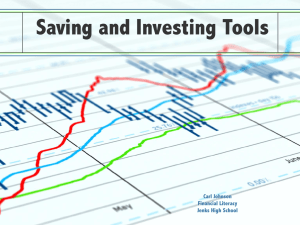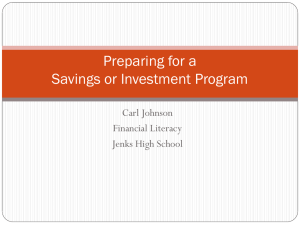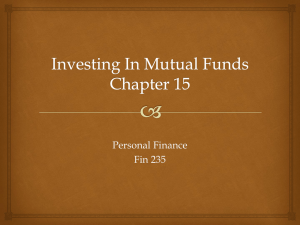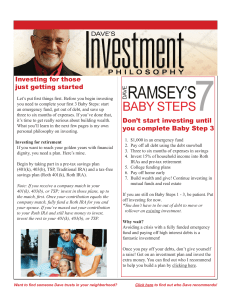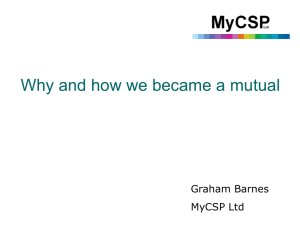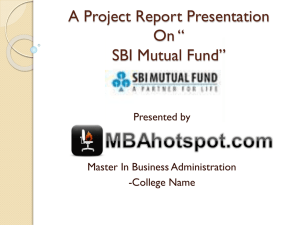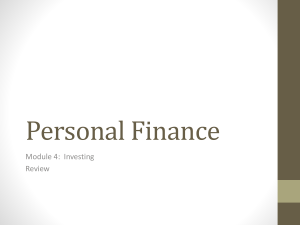Lesson 6 – What are Mutual Funds?
advertisement
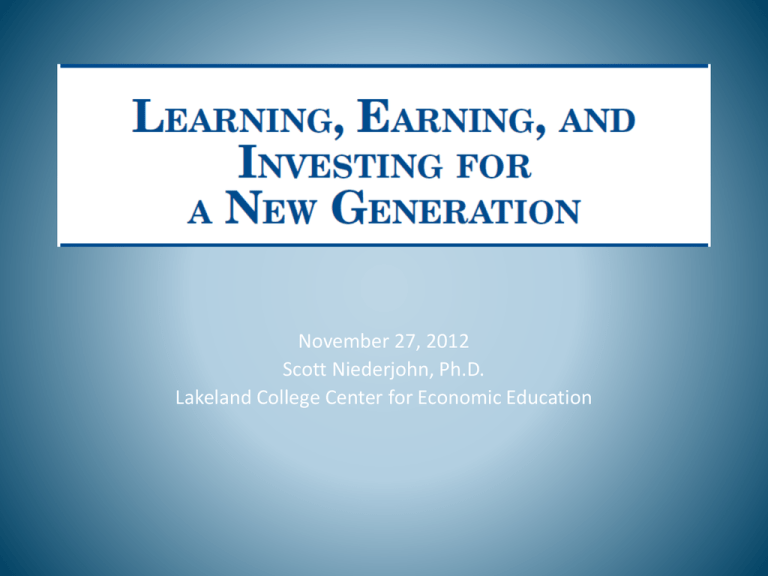
November 27, 2012 Scott Niederjohn, Ph.D. Lakeland College Center for Economic Education Overview • Why Saving and Investing Matters • Overview of LEIG • Lesson 20: The Language of Financial Markets • Lesson 6 What Are Mutual Funds? • Overview of the Gen i Revolution Why It Matters Why Invest? • You can earn income. – Owning stock is like a job. • Rewards last a lifetime. – Investing provides good assets – Stocks, bonds, mutual funds Why Invest? • Time is on your side. – Stock prices rise over time. • Beat inflation. – Overtime, investments in stock have good returns. Why Invest? • Own corporate America--it’s not greed. – Investing helps companies to grow and provide more jobs and income. – Investing helps create new goods and services for consumers. – Investing illustrates a basic principle of economics - - the invisible hand of Adam Smith. But, It’s Scary Out There Why Worry? • I have all the money I’ll ever need… • As long as I die at 4:00 p.m. today. • Henny Youngman Economic and Financial Literacy is Important • Citizens must understand basic economics to: – Fully participate in our nation’s market economy. – Understand policy issues and cast informed votes in federal and state elections. • Citizens must understand personal finance to: – Plan for retirement. – Make saving and investing choices. – Purchase insurance. – Buy a home. Problems Caused by Economic and Financial Illiteracy • Recent Financial Crisis – Consumers’ lack of knowledge about mortgages, interest rates, debt and credit played a part. – “Take the greed and the financial misrepresentation out of it, and the root cause of this crisis is massive levels of financial illiteracy”– John Bryant. Problems Caused by Economic and Financial Illiteracy • An estimated 7.7 percent of U.S. households, approximately 9 million people, are unbanked. • 21.7 percent of African American and 19.3 percent of Hispanic households are unbanked. Problems Caused by Economic and Financial Illiteracy • An estimated 17.9 percent of U.S. households, roughly 21 million people, are underbanked. • An estimated 31.6 percent of African American and 24 percent of Hispanics households are underbanked Where Do the Unbanked and Underbanked Go for Financial Services? Non-Mainstream Financial Institutions • Unbanked/Underbanked households depend on: – Check-cashing outlets – Short-term lenders: Payday loans – Pawnshops – Rent-to-own stores • Unbanked families pay higher fees for using these financial services and face higher risk losses due to dealing in cash. Authors • Scott Niederjohn – Lakeland College • Mark Schug – UW-Milwaukee • Bill Wood – James Madison University What’s New? LESSON 20 THE LANGUAGE OF FINANCIAL MARKETS SLIDE 20.1 LESSON 20 – THE LANGUAGE OF FINANCIAL MARKETS The Language of Financial Markets: Terms Buying and Selling in the Market • Buying on Margin • Commission • Ponzi Scheme • Price • Short Selling Exchanges and Indexes • Dow Jones Industrial Average (DJIA) • NASDAQ Stock Market • New York Stock Exchange (NYSE) • Over-the-Counter Market • S&P 500 Stock Index People in Financial Markets • Broker • Dealer • Institutional Investor • Investment Bank • Stockholder Stocks, Bonds, and Mutual Funds • Bond • Common Stock • Initial Public Offering (IPO) • Index Fund • Mutual Fund • Preferred Stock Technical Terms • Capital Gain • Dividend • Growth Stock • Income Stock • Liquidity • Risk • Return • Stock Spill SLIDE 20.2 LESSON 20 – THE LANGUAGE OF FINANCIAL MARKETS The Language of Financial Markets: Quiz Bowl Score Sheet Group 1 2 3 4 5 Score LESSON 6 WHAT ARE MUTUAL FUNDS? Lesson 6: What Are Mutual Funds? • More Americans invest in stocks and bonds through mutual funds than in any other way. • Mutual funds are like an investment club - - but with thousands of members. Activity 6.1 • Each club has $3,000 to invest. • The club sold $300 shares at $10 each to start the club. • You may buy any of six stocks. • Invest the entire $3,000. • Complete the chart in Activity 6.1. Complete Table 1 Activity 6.1 Complete Table 1 Company Price per Share American Cellular $ 5.00 Big Box Stores $20.00 Biotech Industries $10.00 General Grocery $20.00 Giant Auto $10.00 Gold Mining Group $ 5.00 Total Investment Value No. of Shares Owned Amount Invested SLIDE 6.1 LESSON 6 – WHAT ARE MUTUAL FUNDS? One Year Later: An example This is an example of what might have happened to a class investment club’s share of stock. Investment Value One Year Later Price per Share Number of Shares Owned $8 100 $500 $800 $23 50 $1,000 $1,150 $8 0 $0 $0 General Grocery $22 0 $0 $0 Giant Auto $11 100 $1,000 $1,100 $4 100 $500 $400 $3,000 $3,450 Company American Cellular Big Box Retail Biotech Industries Gold Mining Group Total Investment Value (add last column) Number of shares 300 Amount Invested *Price per share $11.50 *The price per share is the total investment value (one year later) divided by the number of shares. SLIDE 6.2 LESSON 6 – WHAT ARE MUTUAL FUNDS? How Mutual Funds Work • The price per share changes every day and depends on the value of the investments. • The value of the investments depends on the performance of the assets chosen by the fund manager. Unlike members of an investment club, mutual fund investors do not decide which stocks or bonds the fund will buy or sell. The fund manager does that. • A mutual fund charges investors for the financial management it provides. The investor may also pay brokers’ fees and other costs. The lower these costs, the higher the investor’s returns from a set of holdings. • Some mutual funds charge a sales commission called a load. The higher the load, the less the actual investment made on behalf of the investor. Lower loads are better for investors, other things being equal. SLIDE 6.3 LESSON 6 – WHAT ARE MUTUAL FUNDS? Types of Mutual Funds Low Risk and Low Potential Reward High Risk and High Potential Reward Money Bond funds market funds Income funds Growth funds Aggressive growth funds (short-term securities) (high-yield stocks and bond funds) (corporate or longer-term government bonds) (larger company stocks; longterm capital gains) (smaller company stocks; shortand longterm capital gains) What Is the Gen i Revolution? • An interactive, web-based computer game. • Designed to teach students the basics of personal finance and investments. • 15 missions designed to be playable as stand-alone missions. • Also effective as a supplement to classroom instruction. The Story Line • People are losing confidence in their ability to save and invest. • This confusion is called “the Murktide”. The Story Line • The mysterious Monique founded her movement, the Gen i Revolution, to fight the Murktide. • Students take on the role of operatives in Monique’s movement. • In each of the 15 missions, players are briefed and trained by Monique to help their contacts battle the Murktide. The Object of the Game • Accumulate as many points as possible by correctly answering questions and giving good financial advice to contacts. Missions 1. Help Angela build wealth for the long run. 2. Help Verona choose a tentative career. 3. Help Matt to consider whether to continue formal education after he graduates from high school. 4. Help the O'Neil's save $300 a month for a down payment on a new home. 5. Teach Justin about credit. Missions 6. Advise Kai on how to invest his grandmothers $10,000. 7. Convince Paul, Fred and Diana to reconsider their choice of financial institution. 8. Help Uncle Louie learn the basics about stocks. 9. Teach Tyrone and Felicia how to invest in bonds. 10. Teach a group of students how to invest in mutual funds. Missions 11. Advise a Gen I $10 million donor on her investment. 12. Show Jasmine what determines stock prices. 13. Advise Markos on how to weather a crash in the scholarship fund. 14. Advise political leaders on their economic forecasts. 15 Conduct the Red Roosters annual financial planning workshop. How to Play http://www.genirevolution. org/demonstration.php Thank You for Participating • Questions?

